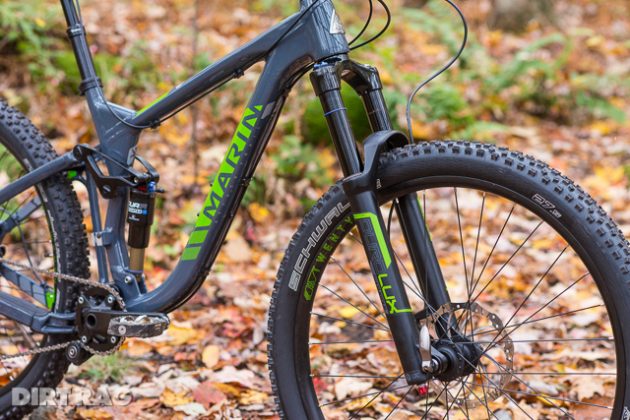Review: Marin Attack Trail 7
Originally posted on April 22, 2016 at 8:00 am
This is our third annual roundup of trail bikes that aren’t priced to the stratosphere. We could call them affordable, budget, real-world, blue-collar or college-fund-friendly, but someone would take offense at our assumption of disposable income level. It doesn’t really matter though. These are great bikes for the price, and we’ll leave it up to you about what to spend. Each bike was hand picked, not just for its price, but its components, geometry and modern features. From Issue #189.
Get an overview of all of the bikes in this test, here, and keep an eye out for full reviews of each.

Tester: Justin Steiner
Age: 33, Height: 5′ 7”, Weight: 165 lbs., Inseam: 31″
Price: $2,749
Sizes: S, M (tested), L, XL
Right off the showroom floor the Marin Attack Trail 7 checks all of the boxes riders are looking for in the 150-160 mm category: wide bars paired with a short stem; a 36 mm chassis fork; single-ring drivetrain; big brakes; good tires on wide, tubeless-ready rims; a dropper post and geometry that’s ready to rally.
When the Attack Trail platform was released in 2014, its geometry felt a bit more progressive than it does now. Reach is the one area where this is most apparent. The 23.3 inch top tube on my medium test bike makes for a somewhat cramped cockpit when paired with a 50 mm stem. In contrast, the 2014 Attack Trail, which utilized the same geometry, offered a roomier cockpit thanks to a longer stem—shorter stems require longer top tubes.

The 66.5 degree head tube angle, while not boundary-pushing, offers a good balance of stability and maneuverability paired to the short-ish top tube. The low bottom bracket also adds stability, yet the suspension rides high enough in the travel to minimize pedal strikes. The short chainstays ease lofting the front wheel and help keep the ride on the lively side.
Up front, the Durolux RC fork offers great performance, holding its own against far more expensive forks. Small bump performance is stellar; it rides high in its travel, offers good mid-stroke control and great bottom out resistance.

Marin’s third-generation Quad-Link suspension design offers a very stable pedaling platform at the slight sacrifice of outright suppleness. Mid- and end-stroke are well controlled, providing great pop off of obstacles and out of corners as well as excellent bottom-out resistance. It’s a design that begs to be ridden aggressively. The harder you push, the better it feels.

The SR Suntour DUAir LO-R rear shock does a great job damping the Attack Trail’s suspension. LO stands for lockout, R for rebound adjustment. Marin spec’d a medium compression tune, which offers a supportive platform in the open setting. The lockout setting, however, feels like a pogo stick. With the lockout engaged, the suspension is hardtail firm, but will blow off a tiny bit on a large impact. Problem is, the rebound circuit is not engaged due to the low volume of oil displaced. So, the shock returns undamped to the top of the stoke and sits there.
When you disengage the lockout, you quickly compress the suspension back down to the sag point. In short, the damping in the open setting is great, but the lockout is virtually unusable. On top of that, the lockout stopped working during my first ride aboard this shock. SR Suntour quickly warrantied the shock, but quality control concerns remain.

The Shimano and Sunrace mixed 1×10 drivetrain performed decently, but suffers the same issues that plague wide-range conversions. Running the SLX derailleur well beyond its specified range with a 42 tooth cog requires cranking up the b-tension in order to clear the big cog. As a result, there’s too much free chain in the small cogs, making for slow, vague shifts.
Magura’s MT4 brakes offer good initial bite and great modulation but offer a touch less outright stopping power than some of the competition. The stock TranzX dropper post is certainly better than no dropper, but its limited travel feels awfully short compared to today’s 125-150 mm options.

Contrast the Attack Trail’s geometry with Transition’s much more progressive Patrol (also in this issue), which offers a slacker headtube, longer wheelbase, is almost as low, yet offers significantly shorter chainstays. On the downhills, the Patrol is a beast. As an all-around bike, the Attack Trail will feel more versatile. Riders looking for a capable and versatile enduro-style bike that ascends nearly as well as it descends should give the Attack Trail lineup consideration. Overall, the Attack Trail 7 offers very compelling performance for the asking price.

Pluses
- Good balance of stability and agility for trail riding
- Ready-to-rally suspension performance encourages aggressive riding
- Great components for the price point, includes dropper post
Minuses
- Vague shifting from mixedbrand, wide-range 1×10 drivetrain
- Short-travel dropper is better than no dropper, but more travel would be better
- 35 mm handlebar clamp diameter limits stem choice
Details
- Wheelbase: 45.3”
- Top Tube: 23.3”
- Head Angle: 66.5º
- Seat-Tube Angle: 73.5º
- Bottom Bracket: 13.2”
- Rear Center: 17.1”
- Weight: 33.1lbs. w/o pedals (specs based on size tested)